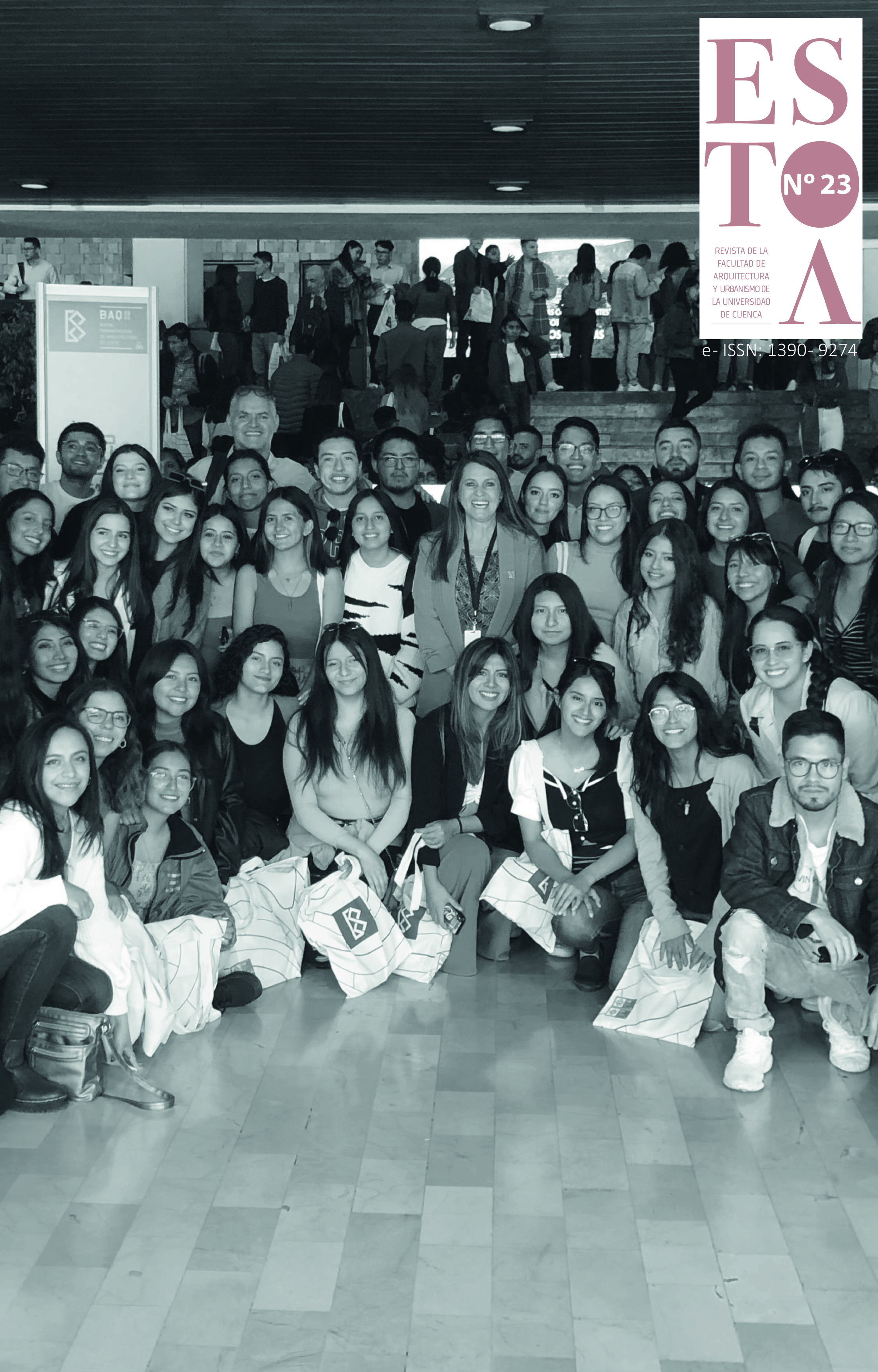Within Aquatic Life. Beyond the Anthropogenic Maritorium Prospect
DOI:
https://doi.org/10.18537/est.v012.n023.a01Keywords:
maritorium, aquatic life, degradation, built environment, historical insightAbstract
Enquiries into non-anthropogenic cultural landscapes, such as marine environments, reveal unsuspected dynamics due to the resurgence of
ecosophies that are alien to the globalised economy and territorialisation as a basis for appropriation and subsequent indiscriminate exploitation. Disturbed by the wanderings of geo-engineering, several regions of the world have recently touched on key arguments with points in common that could revitalise nonhuman biospheres and, in them, human ones. When considering maritime dynamics, the ocean must be seen as an entity. Following the ever-inspiring
historical literatures of Fernand Braudel and expanding on the “mediterraneity” he formulated, we would be testing another concept involving a change in mentality of governmentality: “maritoriums”, a conceptualisation from 1970s Chilean architecture. Based on case studies, we will discuss significant examples in the Mediterranean, the Caribbean and Asian oceans and rivers that contribute to the current debate on.
Downloads
References
Álvarez, R., Ther-Ríos, F., Skewes, J., Hidalgo, C., Carabias, D., García, Ch. & Álvarez, R. (2019). Reflexiones sobre el concepto de maritorio y su relevancia para los estudios de Chiloé contemporáneo. Revista Austral de Ciencias Sociales, 36, 115–126. https://doi.org/10.4206/rev.austral.cienc.soc.2019.n36-06
Alves, A., Gómez, J. P., Vojinovic, Z., Sánchez, A., & Weesakul, S. (2018). Combining co-benefits and stakeholders perceptions into green infrastructure selection for flood risk reduction. Environments - MDPI, 5(2), 1–23. https://doi.org/10.3390/environments5020029
Ang, R. (2021). S’pore fish farm to aim for highest sustainable farming standards in aquaculture. www.straitstimes.com. https://www.straitstimes.com/singapore/environment/spore-fish-farm-to-aim-for-highest-sustainable-farming-standards-in
Bennett, N. J., Blythe, J., White, C. S., & Campero, C. (2021). Blue growth and blue justice: Ten risks and solutions for the ocean economy. Marine Policy, 125, 104387. https://doi.org/10.1016/j.marpol.2020.104387.
Bolaños, O., Herrera Arango, J., & Arrieta, M. J. (2020). Collective land tenure in island areas of Colombia: legal challenges and obstacles. 2020 World Bank Conference on Land and Poverty. (1-19). The World Bank.
Braudel, F. (2011). Memory and the Mediterranean. Knopf Doubleday Publishing Group.
Braudel, F., & Reynolds, S. (1995). The Mediterranean and the Mediterranean World in the Age of Philip II: Volume I. University of California Press.
Braudel, F., & Reynolds, S. (2002). The Perspective of the World. Phoenix Press.
Dhakal, S. & Shrestha, A. (2016). Bangkok, Thailand. In S. Bartlett & D. Satterthwaite (Eds.), Cities on a Finite Planet: Towards transformative responses to climate change (pp. 63–68). Taylor & Francis.
Duarte, C. M., Wu, J., Xiao, X., Bruhn, A., & Krause-Jensen, D. (2017). Can seaweed farming play a role in climate change mitigation and adaptation? Frontiers in Marine Science, 4(100). https://doi.org/10.3389/fmars.2017.00100
Engelbrecht, H. (1999). ReORIENT: Global Economy in the Asian Age. International Journal of Social Economics, 26(12). https://doi.org/10.1108/ijse.1999.26.12.1505.3
Fanfani, D. (2020). Bioregional Planning and Design: Volume II. In Bioregional Planning and Design. Springer. https://doi.org/10.1007/978-3-030-46083-9
Frame, M. (2021). Ecological Imperialism. In I. Ness & Z. Cope (Eds.), The Palgrave Encyclopedia of Imperialism and Anti-Imperialism (p. 693). Springer International Publishing. https://doi.org/10.1007/978-3-030-29901-9_300300
Gaynor, J. L. (2005). The decline of small-scale fishing and the reorganization of livelihood practices among Sama people in eastern Indonesia. MPublishing, University of Michigan Library. https://doi.org/http://hdl.handle.net/2027/spo.0522508.0015.105
Gottberg, V. (2020). Challenging Old Truths: Viewing Cultural Hybridity from the Perspective of the Tarand-Graves TT - Att utmana gamla sanningar: Kulturell hybriditet betraktat utifrån tarandgravarna (swe): Uppsala Universitet. http://uu.diva-portal.org/smash/get/diva2:1446327/FULLTEXT01.pdf
Grossman, L. S. (1998). The Political Ecology of Bananas: Contract Farming, Peasants, and Agrarian Change in the Eastern Caribbean. Geographical Review, 88(3), 447. https://doi.org/10.2307/216023
Ivelic, B. (1971). Maritorios de los archipiélagos de la Patagonia occidental. In Fundamentos de la Escuela de Arquitectura UCV (pp. 1–18). Talleres del Consejo de Rectores.
Kiguchi, M., Takata, K., Hanasaki, N., Archevarahuprok, B., Champathong, A., Ikoma, E., Jaikaeo, C., Kaewrueng, S., Kanae, S., Kazama, S., Kuraji, K., Matsumoto, K., Nakamura, S., Nguyen-Le, D., Noda, K., Piamsa-Nga, N., Raksapatcharawong, M., Rangsiwanichpong, P., Ritphring, S., … Oki, T. (2021). A review of climate-change impact and adaptation studies for the water sector in Thailand. Environmental Research Letters, 16(2), 23004.
Kodama, K., & Horiguchi, T. (2011). Effects of hypoxia on benthic organisms in Tokyo Bay, Japan: a review. Marine Pollution Bulletin, 63(5–12), 215–220. https://doi.org/10.1016/j.marpolbul.2011.04.022
Kropotkin, P.(2017). Mutual Aid: a Factor in Evolution. Independently Published. [1902]
Ladiqi, S., Salleh, M., Wardhani, B., Dugis, V., & Wekke, I. (2019). Identity & The Globalization of Nusantara. Proceedings of the International Conference on Environmental Awareness for Sustainable Development in Conjunction with International Conference on Challenge and Opportunities Sustainable Environmental Development, ICEASD & ICCOSED 2019, (pp. 1-7). https://doi.org/10.4108/eai.1-4-2019.2287291
Márquez Pérez, A. I. (2019). Acaparamiento de territorios marinos y costeros: dos casos de estudio en el Caribe colombiano. In Revista Colombiana de Antropología 55(1), 119–152. https://doi.org/10.22380/2539472X.573
Márquez-Pérez, A. I. (2022). Legalized Injustices: Old Providence Island (Colombia) Small-Scale Fisheries in the Context of Geopolitical Disputes and State Power. In Blue Justice (pp. 215-232). Springer. https://doi.org/10.1007/978-3-030-89624-9_12
Martín-Antón, M., Negro, V., del Campo, J. M., López-Gutiérrez, J. S., & Esteban, M. D. (2016). Review of coastal Land Reclamation situation in the World. Journal of Coastal Research, 75(sp1), 667–671. https://doi.org/10.2112/SI75-133.1
Michelet, J. (1861). The sea (La mer). Rudd & Carleton.
Miyashita, A. (1970). Nori no Rekishi (History of Nori). Library Publishing Co.
Moore, J. W. (2003). Capitalism as World-Ecology: Braudel and Marx on Environmental History. Organization and environment, 16(4), 431–458. https://doi.org/https://doi.org/10.1177/1086026603259091
Nutalaya, P. (1996). Coastal erosion in the Gulf of Thailand. GeoJournal, 38(3), 283–300. www.jstor.org/stable/41146843
Pernice, R. (2007). The Issue of Tokyo Bay’s Reclaimed Lands as the Origin of Urban Utopias in Modern Japanese Architecture. Journal of Architecture and Planning (Transactions of AIJ), 72(613), 259–266. https://doi.org/10.3130/aija.72.259
Ramos, J. M. (2010). Alternative futures of globalisation a socio-ecological study of the world social forum process [Queensland University of Technology]. https://eprints.qut.edu.au/40986/
Sakamoto, A., & Shirakihara, K. (2017). Ecosystem dynamics in Tokyo Bay with a focus on high trophic levels using Ecopath with Ecosim. Journal of Marine Science and Technology, 22(1), 1–10. https://doi.org/10.1007/s00773-016-0388-8
Schroeder, B. (2000). Bioregionalism and Territorialization. Call to Earth, 1(1), 10–14. https://www.jstor.org/stable/44898505
Sutherland, H. (2003). Southeast Asian History and the Mediterranean Analogy. Journal of Southeast Asian Studies, 34(1), 1–20. https://www.jstor.org/stable/20072472
Swyngedouw, E. (2021). El apocalipsis es decepcionante: el punto muerto despolitizado del consenso sobre el cambio climático. Punto Sur, (5), 6-23. http://revistascientificas.filo.uba.ar/index.php/RPS/article/view/10997
Tacconi, L. (2019). Moving Indonesia’s capital city won’t fix Jakarta’s problems and will increase fire risk in Borneo. The Conversation.
Wallerstein, I. M. (2004). World-systems Analysis: An Introduction. Duke University Press.
Wehlin, J. (2013). Baltic Stone Ships. Monuments and Meeting places during the Late Bronze Age [Göteborgs universitet. Humanistiska fakulteten]. http://hdl.handle.net/2077/31901
Whistler, R., & BeMiller, J. (1973). Industrial Gums: Polysaccharides and Their Derivatives. Academic Press.
Published
How to Cite
Issue
Section
License
Copyright (c) 2022 Estoa. Revista de la Facultad de Arquitectura y Urbanismo

This work is licensed under a Creative Commons Attribution-NonCommercial-ShareAlike 4.0 International License.
The Journal declines any responsibility for possible conflicts derived from the authorship of the works that are published in it.
The University of Cuenca in Ecuador conserves the patrimonial rights (copyright) of the published works and will favor the reuse of the same ones, these can be: copy, use, diffuse, transmit and expose publicly.
Unless otherwise indicated, all contents of the electronic edition are distributed under a Creative Commons Attribution-NonCommercial-ShareAlike 4.0 International License.




